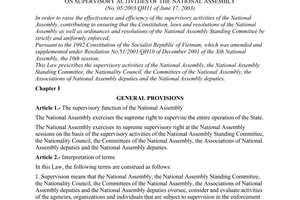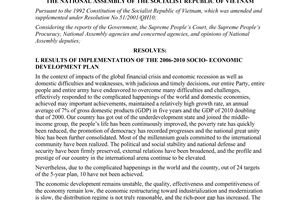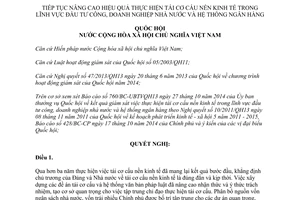Nội dung toàn văn Resolution No. 86/2014/QH13 the economic restructuring in public investment state enterprises
|
THE NATIONAL ASSEMBLY |
THE SOCIALIST REPUBLIC OF VIETNAM |
|
No. 86/2014/QH13 |
Hanoi, November 28, 2014 |
RESOLUTION
ON FURTHER INCREASING THE EFFECTIVENESS OF THE ECONOMIC RESTRUCTURING IN PUBLIC INVESTMENT, STATE ENTERPRISES AND BANKING SYSTEM
THE NATIONAL ASSEMBLY OF THE SOCIALIST REPUBLIC OF VIETNAM
Pursuant to the Constitution of the Socialist Republic of Vietnam;
Pursuant to Law No. 05/2003/QH11 on Supervisory Activities of the National Assembly;
Pursuant to the National Assembly’s Resolution No. 47/2013/QH13 of June 20, 2013, on the National Assembly’s 2014 supervisory program;
Considering the National Assembly Standing Committee’s Report No. 760/BC-UBTVQH13 of October 27, 2014, on results of supervision of the economic restructuring in public investment, state enterprises and banking system under the National Assembly’s Resolution No. 10/2011/QH13 of November 8, 2011, on the five-year 2011-2015 socio-economic development plan; the Government’s Report No. 428/BC-CP of October 17, 2014; and opinions of National Assembly deputies;
RESOLVES:
Article 1.
Over the past three plus years, the economic restructuring has recorded initial outcomes, affirming the sound and timely policy of the Party and the State on economic restructuring. The formulation of restructuring plans and the legal system has raised the awareness and the sense of responsibility, laying important grounds for directing the restructuring. The allocation of state budget and government bond capital sources has focused on important and urgent projects and effective ongoing projects. Mobilized private and foreign investments in public investment projects have increased in the construction of transport infrastructure. State enterprises continue to be arranged, strengthened and renovated to focus on their core business lines. Their equitization and divestment of capital invested in non-core business lines have recorded positive results in 2014. Credit institutions have improved their solvency; the system safety has been ensured; and the handling of non-performing loans of commercial banks has achieved initial outcomes. The results of restructuring the three key fields have comprehensively impacted the socio-economic situation and growth, created jobs, reduced poor households, and increased income. The scientific and technological potential has been further promoted in terms of both physical facilities and human resources.
However, the restructuring process has revealed a clearer picture of the actual economic situation. The new growth model has not yet been shaped. The relationship between the restructuring of the three key fields and that of the whole economy has not yet been exhaustively defined. The supporting industry has not yet met requirements, while the manufacturing industry develops slowly and the assembly industry still makes up a large proportion. No breakthrough and comprehensive solutions have been identified yet to make full use of the advantages of agricultural production. The competitiveness of the economy has improved slowly. The rate of trained laborers remains low compared with the demand of the economic restructuring. Policies are not strong enough to attract resources from the private sector and foreign investors to invest in the public sector. Investment in high technology and other industries that are able to lead the economic restructuring toward modernity has not yet met requirements. The restructuring of state enterprises remains slow and sees no breakthroughs. The assignment, decentralization and delegation in the exercise of the rights and performance of the tasks of owners and representatives of state owners remain overlapping, and business administration is slow to renovate. Some measures supporting the restructuring of credit institutions and the handling of non-performing loans prove to be ineffective and some have not been closely combined with measures to restructure state enterprises and public investment. The handling of cross ownership and cross investment in the credit institution system remains slow.
Most limitations of the economic restructuring process are attributable to subjective causes, such as restructuring plans have not yet identified specific targets and not been carried out in a coordinated manner; their approval is slower than required; some ministries, sectors and localities even have not come up with any restructuring plans; many urgent problems have been settled just halfway or confusingly; the institutional reform and administrative procedure reform linked with the economic restructuring have not been properly coordinated and lack significant breakthroughs; the restructuring responsibilities of heads of sectors, localities and state enterprises are yet to be concretized; the coordination and cooperation among levels, sectors and localities in directing, guiding and organizing the performance of economic restructuring tasks are not proactive and close; the management mechanism and the quality of managers of state enterprises fail to meet requirements; the supervision, inspection, examination, monitoring as well as identification and handling of responsibilities have not yet been conducted regularly and seriously; mobilization and propaganda work to involve the whole society in the restructuring process is still limited.
Article 2.
In order to further increase the effectiveness of the economic restructuring from now to the end of 2015, the Government shall focus on implementing the following major tasks and measures:
1. To focus on implementing the objectives, tasks and solutions set out in the master plan on economic restructuring under the National Assembly’s Resolution No. 10/2011/QH13 of November 8, 2011, on the five-year 2011-2015 socio-economic development plan, in order to basically complete the economic restructuring toward rapid and sustainable development, achieving harmony among the growth, macro-economic stability and social welfare objectives;
2. To supplement and improve the restructuring plan by quantifying growth model contents, clearly stating the objectives, roadmap and methods of re-allocating resources, mobilizing the social engagement, associating the economic restructuring process with the international economic integration process, and associating the industrial and service restructuring with agricultural restructuring. To finish the approval of restructuring plans for all sectors and localities by the second quarter of 2015 at the latest. To create substantial changes right in 2015 in the application of scientific and technological advances to production and business activities; to consider training of high-quality human resources with high scientific and technological qualifications the decisive factor for increasing labor productivity; to develop the labor market in pace with the economic restructuring process, balance labor supply and demand, reasonably restructure labor, and increase labor productivity and product quality; to promote the manufacturing, processing and supporting industries; to improve the linkage among regional localities;
3. To continue revising laws in accordance with the Constitution and submitting them to the National Assembly for amendment or promulgation; to fully and timely issue guiding documents and properly implement laws passed by the National Assembly. To submit to the National Assembly the draft Law on Planning in order to raise the quality of socio-economic development, sectoral and territorial planning work as a basis for formulating mid- and long-term investment programs and plans, and ensure discipline and unity in planning work;
4. To promote the restructuring of agriculture, including cultivation, animal raising, aquaculture, silviculture, processing and agricultural services, in order to develop sustainable agriculture, effectively implement the Political Bureau’s Resolution No. 30-NQ/TW of March 12, 2014, on continued arrangement, renewal, development and improvement of the operational effectiveness of agricultural and forestry companies, and further strongly implement the Xth Party Central Committee’s Resolution No. 26- NQ/TW of August 5, 2008, on agriculture, farmers and rural areas. To continue effectively implementing the new-countryside building program;
5. To draw up and implement specific plans and policies encouraging and attracting non-state investment to develop socio-economic infrastructure facilities, which will replace a significant part of public investment. To improve and strongly implement public-private partnership (PPP) forms. To continue reviewing and completely investing in unfinished public investment projects with socio-economic effectiveness; to concentrate investment on science and technology and human resources development. Capital construction debts must not recur. To renovate and modernize the public investment information and data management;
6. To completely implement the state enterprise arrangement and renovation plan as scheduled and pay attention to properly dealing with the labor redundancy; to improve the effectiveness of the mechanism of state owner representation by separating the functions of owners, owner representatives and state administration. To promote financial supervision, operational supervision and change of enterprise leaders and managers, contributing to raising the operational effectiveness of state enterprises. To implement the equitization plan and roadmap for public-utility enterprises and facilitate the development of social enterprises. To study and propose a plan on using the proceeds from the equitization of and divestment of state capital from stated-invested enterprises to invest in urgent projects and works and ease the public debt burden, and report it to the National Assembly;
7. To arrange and restructure weak credit institutions, continue implementing measures to reduce non-performing loans to below 3 percent of the total outstanding loans by the end of 2015. To continue studying and improving the operational mechanism of the Vietnam Asset Management Company. To expeditiously supplement and complete regulations to solve difficulties and problems in handling collaterals, and develop the debt trading market. To increase the inspection and examination of the law compliance by credit institutions, closely supervise the cross ownership and cross investment, promptly handle violations and prevent risks. To basically control the cross ownership and cross investment in accordance with law by the end of 2015;
8. To identify responsibilities in order to strictly handle heads of ministries, sectors, localities and state enterprises in slowly or improperly implementing the approved restructuring plans. To improve the coordination among state management agencies in the economic restructuring process;
9. To drastically reform public administration and public finance toward clarifying tasks, powers and responsibilities of each sector and level; to enhance the autonomy and self-responsibility of heads of ministries, sectors and localities; to improve the discipline, effectiveness and efficiency in the state administration and use of public finance.
On the basis of assessing the economic restructuring during the five-year 2011-2015 period, the Government shall prepare an economic restructuring plan for the 2016-2020 period, and report it to the National Assembly at its 10th session in October 2015. In the following years, to strongly implement solutions to achieve the objectives and orientations set out in the 2011-2020 Socio-Economic Development Strategy; effectively and synchronously implement the three strategic breakthroughs, attaching importance to the factors contributing to the growth model change, including development of the industry and service proportion, values of hi-tech and hi-tech applied products, values of products of manufacturing and supporting industries, and the total factor productivity; to improve the quality of human resources with high scientific and technological qualifications, considering this the decisive factor for increasing labor productivity.
Article 3.
The Government shall, within the ambit of its functions, tasks and powers, organize the implementation of this Resolution with the highest effectiveness and report it to the National Assembly at the year-end session of 2015.
The National Assembly Standing Committee, the Ethnic Council and the Committees of the National Assembly, National Assembly deputies’ delegations and individual deputies shall supervise the implementation of this Resolution.
The Vietnam Fatherland Front Central Committee, member organizations of the Front and lawfully established social organizations shall supervise the implementation of, and encourage people of all strata to implement, the National Assembly’s Resolution.
This Resolution was adopted on November 28, 2014, by the XIIIth National Assembly of the Socialist Republic of Vietnam at its 8th session.-
|
|
CHAIRMAN OF THE NATIONAL ASSEMBLY |



